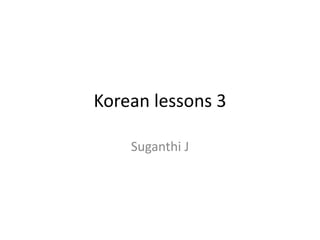
Korean lessons 3
- 2. Introduction • Hello everyone! The last lesson we learned was the revision of previous lessons and some phrases that you might need! • In this lesson, we will learn about Korean numbers and how you can use them. • I’ll just give simple notes here and from the next presentation we’ll go in depth!
- 3. Before we go.. • Just like previous lesson, I’ll give some more words in romanisation, write them in Korean! • Mul- Water • Angyeong- Glasses • Taeyang- Sun • Yangmal-Socks • Shinbal-Shoes • Bihaenggi-Aeroplane • Chaeg-Book
- 4. Let’s get started! • Like I said, today we will start with Korean number system. • Koreans use two number systems for their daily use. • It is IMPORTANT to learn both, in order to sound like a native speaker. So can we start! • The two number systems used commonly are, o Sino-Korean number system o Native Korean number system
- 5. Sino-Korean number system • This is a number system derived from Chinese characters so it has a long history. • This is a very simple very easy, as even 100, 1000, 10000 has only one syllable!! • To learn every number you’ll ever need to know in this Korean counting system, you only need to memorize 18 numbers! • That’s right! Learn the set of numbers 1-10 plus the words for hundred, thousand, ten thousand and a few increments after that and you can create all the other numbers easily through simple combinations.
- 6. Sino-Korean number system • With the first ten numbers, you can create all the numbers up to 99. English Korean One IL (일 ) Two EE (이) Three SAM (삼 ) Four SAA (사 ) Five OH (오 ) Six YUK (육) Seven CHIL (칠 ) Eight PAL (팔) 구 십 Nine GU (구) Ten SHIB ( 십)
- 7. Sino-Korean number system • Creating a number till 99 is easy! For example, 10 in Korean is 십 (sip). 20 in Korean is literally “two-ten” (이십 | isip), 30 is “three-ten” (삼십 | samsip) and so on. • In fact, if we just remember the words for one hundred, one thousand, and ten thousand, we are able to create combinations that create the other numbers. English Korean ONE HUNDRED 백 (baek) ONE THOUSAND 천 (cheon) TEN THOUSAND 만 (man) ONE HUNDRED THOUSAND 십만 (simman) ONE MILLION 백만 (baengman) TEN MILLION 천만 (cheonman) ONE HUNDRED MILLION 일억 (ireok) ONE BILLION 십억 (sibeok)
- 8. Sino-Korean number system • Now try to say the following numbers in Korean! 90 30 25 50 63 • The same will apply for numbers from 100 100 and ten thousand too, just stick the ones place digit at the end. • For eg: 1001 is just cheon il
- 9. Native Korean number system • The Native Korean numbers system is a bit more modern than the Sino-Korean numbers system. The first number in the Native Korean numbers system is 하나 (hana), which is shortened to 한 (han) when counting in Korean. • This makes it easy to remember as the Native Korean numbers system, considering that 한국 (hanguk) means “Korea.” They have the same first syllable!
- 10. Native Korean number system • Let’s memorize 1- 10 first! • English Korean o ONE 하나 (hana) o TWO 둘 (dul) o THREE 셋 (set) o FOUR 넷 (net) o FIVE 다섯 (daseot) o SIX 여섯 (yeoseot) o SEVEN 일곱 (ilgop) o EIGHT 여덟 (yeodeol) o NINE 아홉 (ahop) o TEN 열 (yeol)
- 11. Native Korean number system • Once you have one to ten memorized, then it’s easy for 11-19! Just like Sino-Korean system, add ones place numbers to yeol! • You have to remember 20 and 30 20 - 스물 (seumul) (after you know this, this just works as yeol to say 21, 22, 23 etc) 30 서른 (seoreun) (also same as yeol)
- 12. Native Korean number system • One good thing about native Korean system is.. It only goes up to 99! Now we have numbers from 40 to 90. Just add ones place just like previous! • English Korean o FORTY 마흔 (maheun) o FIFTY 쉰 (swin) o SIXTY 예순 (yesun) o SEVENTY 일흔 (ilheun) o EIGHTY 여든 (yeodeun) o NINETY 아흔 (aheun)
- 13. Conclusion • The two systems are used at different times and for different purposes. One system will be used at a given time, depending on the purpose of communication. The only exception where the two systems are mixed is for telling time. We say the hours using the Native Korean numbers and the minutes using the Sino-Korean numbers! • The Sino-Korean numbers system is used for time (minutes), units of time, the names of months, money, saying phone numbers, measurements, and so much more! • Also, since the Native Korean numbers system only goes up to 99, it’s used for any number 100 or greater by default. It’s a very useful system! • On the other hand, the Native Korean numbers system is used for counting things and people, age, time (hours) and for counting in general! • For now, that’s your next mission — to count in Korean using the first set of numbers in the Native Korean numbers system.
